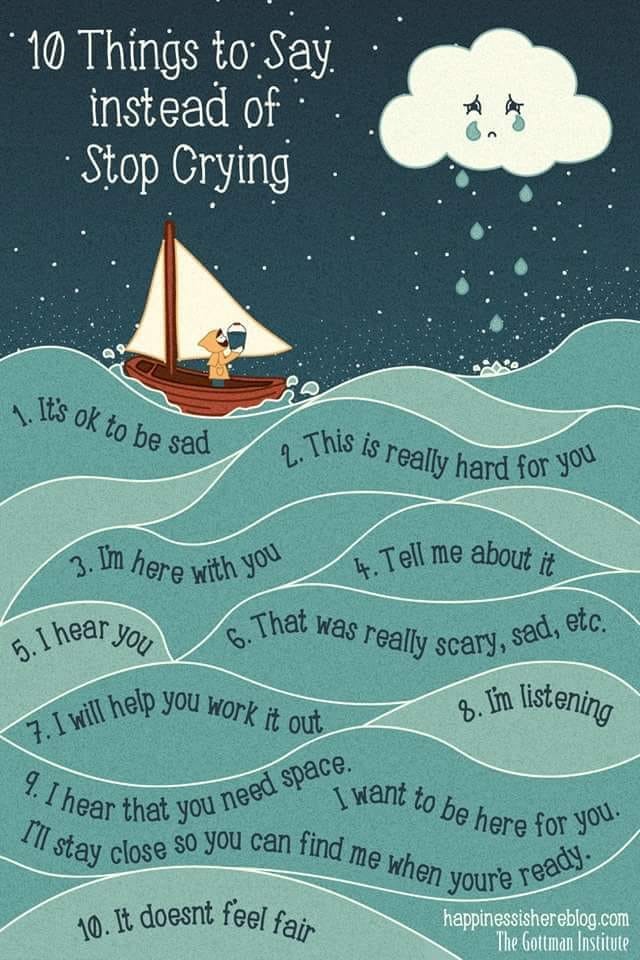When a newborn arrives, it calls out into the world. As her parents take her into their arms and provide care they learn to respond to her cries. When she is hungry she is nursed or bottle fed.┬Ā When he is uncomfortable his diaper is changed.┬Ā Sometimes the young baby is carried on the parentŌĆÖs shoulder, patted and whispered to, and the crying stops.┬Ā The parent feels connected and accomplished. Their love builds with their ability to understand and respond to their infant.

Then things get more complicated.┬Ā A newborn will cry into the night, even when all efforts to respond have been exhausted.┬Ā┬Ā A toddler will explode when he gets a blue sippy cup instead of a red one, and then when the red one is provided, the cup will be tossed across the room.┬Ā A teenager will come home from a party, lock herself in her room and sob.
Parents often feel helpless in the face of crying that doesnŌĆÖt make immediate sense to them.┬Ā Since they have learned from their newborn that crying is a way to send a signal for the parent to help out, parents sometimes feel that a child is manipulating them when they cry.┬Ā When the 2nd cookie is provided the child immediately calms down.┬Ā Does this mean the child is producing ŌĆ£crocodile tears?ŌĆØ
A good place to start in understanding the meaning of crying is to look at the biological nature of tears.┬Ā There are three types of tears:
- Basal: Tear ducts continuously release basal tears that contain an antibacterial liquid that moisten the eyes when a person blinks.
- Reflex: These tears are triggered by irritants such as smoke, wind or onions. The tears flush out irritants and protect the eyes.
- Emotional: Humans shed tears in response to emotional stimuli. These tears contain a higher level of stress hormones than other type of tears.
Emotional tears are either considered to be manipulative, as in trying to get someone else to do something for them, or as a sign of weakness. Early on children are told not to cry as a way for the adult to gain control, or in an attempt to stop the pain the child is feeling. We all have picked up a tearful baby and said, ŌĆ£sh, sh, sh,ŌĆØ our cultureŌĆÖs sound for hushing. Boys are especially given the message that crying is childish and un-masculine. ŌĆ£Big Boys DonŌĆÖt CryŌĆØ is a song from the 1990ŌĆÖs and ŌĆ£Boys DonŌĆÖt CryŌĆØ is a movie from the same era. This suppression of tears drives sadness and grief underground, but it doesnŌĆÖt solve the emotional issue that led to the crying in the first place.
In fact, children and adults cry for many legitimate reasons.┬Ā It reduces the stress that accompanies painful emotion.┬Ā Scientists believe that crying activates the parasympathetic nervous system, which calms and relaxes the body. Crying is also self-soothing, by releasing oxytocin and endorphins, hormones which relieve pain, and help a person return to a state of well-being.┬Ā Some scientists also believe that emotional tears contain chemical toxins that get released when crying. Long-term it is dangerous to the body to hold in emotions and that over the course of a life time this can put a person at risk for depression, heart disease and hypertension, as well as other illnesses.
To return to parent and child, crying is at its base an attachment response. A child learns that crying will pull their loved one closer, that they will not be alone with their distress and painful emotion.┬Ā Parents know what to do when there is a problem to be solved ŌĆō a diaper to change, or a scraped knee to be washed and bandaged.┬Ā But whatŌĆÖs a parent to do when the crying does not appear to be attached to a problem that can respond to a solution in the moment?
Parent educator Patty Wipfler has coined a term called, ŌĆ£staylistening.ŌĆØ┬Ā It refers to the act of staying with your child and listen to their crying and their upset until they are finished.┬Ā ŌĆ£You meet your crying child with an open heart and stay with her until she recovers.ŌĆØ┬Ā You donŌĆÖt have to ask a lot of question of him or ask him to use his words to interrupt the flow of tears to tell you what is upsetting him.┬Ā If necessary, you can hear about that later.┬Ā For the moment, you just stay with them and let them know you are there. You give them loving and reassuring messages that you know they can get through these difficult feelings.┬Ā Your presence is all they need.
Once a child has cried it out, they will be able to think more clearly about whatever made them sad or scared.┬Ā ItŌĆÖs important to separate the pain from the crying.┬Ā Crying is the healing from the pain ŌĆō not the pain itself. As a therapist, I always tell children and adults alike, ŌĆ£The crying is the sadness leaving your body.ŌĆØ
Staylistening isnŌĆÖt easy and there isnŌĆÖt always the time or attention for you to provide this to your child. But when you can you will both grow from the experience, and grow closer.
Below are 10 things you can say to a crying child:
References:
Lana Burgess, ŌĆ£Eight benefits of crying: Why its good to shed a few tearsŌĆØ ┬ĀOctober, 2017.
https://www.medicalnewstoday.com/articles/319631.php
Alia Hoyt, ŌĆ£How Crying WorksŌĆØ┬Ā July, 2008
https://science.howstuffworks.com/life/inside-the-mind/emotions/crying.htm
Patty Wipfler and Tosha Schore, Listen: Five Simple Tools to Meet Your Everyday Parenting Challenges, Hand in Hand Parenting, 2016.
